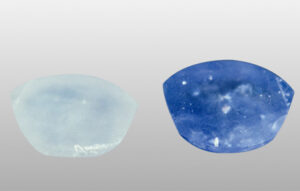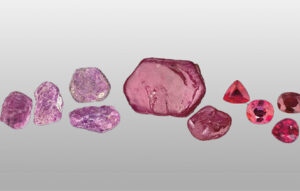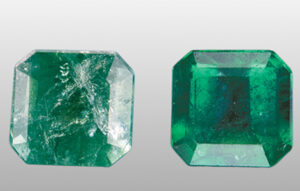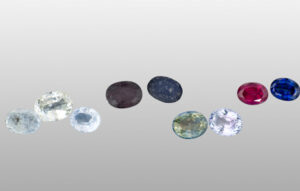Treated Precious Gemstones
Most gemstones undergo some form of treatment, and this practice is particularly common among precious stones like sapphires, rubies, and emeralds. While these gemstones are naturally beautiful, treatments are often applied to enhance their color, clarity, and overall appearance, making them more desirable in the market. Additionally, treatments can improve a stone’s durability and structural integrity, which is especially important for gemstones that are prone to inclusions or fractures.
Understanding these treatments is crucial for both buyers and collectors, as they significantly influence a gemstone’s value, authenticity, and long-term care requirements.
Although treated, these gemstones are naturally formed through geological processes within the Earth and should not be confused with synthetic or lab-created stones. Synthetic or lab-created stones are man-made and mimic the appearance and properties of natural gems, but they do not occur naturally. Despite having similar chemical compositions and physical properties to natural gemstones, synthetic or lab-created stones are significantly less valuable due to their lack of rarity and the fact that they are produced artificially.
UnTreated Precious Gemstones
Although most gemstones are treated, there are natural gemstones that are not treated at all, and they are highly sought after for their rarity and natural beauty. The occurrence of untreated gemstones largely depends on the type of stone and the quality of the crystal found in nature.
Untreated Sapphires
While most sapphires are heat-treated to enhance color and clarity, some high-quality sapphires possess excellent color and clarity naturally and do not require any treatment. Untreated sapphires with rich color (like deep blue, padparadscha, or pink) are highly valuable and rare.
Untreated Rubies
Similar to sapphires, most rubies are heat-treated to improve their color and clarity. However, high-quality rubies from certain regions, like Myanmar (Burma), can be found in a natural state with excellent red color and minimal inclusions. These untreated rubies are rare and command premium prices in the market.
Untreated Emeralds
While nearly all emeralds are treated with oils or resins to fill fractures, some top-quality emeralds, especially from Colombia, do not require any treatment due to their exceptional natural clarity and vivid green color. Such untreated emeralds are exceedingly rare and highly prized
Heat Treatment
Purpose: Improves color and clarity.
Sapphires: Heat treatment is the most common and accepted practice for sapphires. It can enhance the blue color, reduce inclusions, or eliminate a grayish tone. Some sapphires undergo low-temperature heat treatment, while others are subjected to higher temperatures (up to 1800°C) for more significant effects.
Rubies: Heat treatment in rubies is primarily done to intensify the red color and reduce inclusions. This process can also heal fractures in rubies by filling them with residual materials like flux.
Emeralds: While less common, some emeralds undergo heat treatment to enhance their green color. However, due to their delicate structure, this is not as frequently applied.
Impact on Price: Generally increases the price of gemstones, particularly sapphires and rubies. Heat treatment is widely accepted and often enhances the stone’s color and clarity, making it more valuable. However, the price premium depends on the extent of treatment and the stone’s quality before treatment.
 Pale sapphires that were once discarded in the mining process
Pale sapphires that were once discarded in the mining process
were treated to a desirable color of blue when heated in a controlled environment.
GIA: https://www.gia.edu/gem-treatment
Fracture Filling
Purpose: Improves clarity by filling cracks and fractures with a substance.
Sapphires: Though less common, some sapphires undergo fracture filling with glass or other materials to enhance clarity.
Rubies: Fracture filling is frequently used for rubies, especially those with significant internal fractures. These rubies are often treated with lead glass, which can dramatically improve clarity and the overall appearance.
Emeralds: Emeralds are notoriously included (with many internal fractures). They are often treated with oils (like cedarwood oil) or synthetic resins to fill these fractures and improve clarity. This is one of the most common treatments for emeralds.
Impact on Price: Can lower the price of gemstones, especially rubies and emeralds. While fracture filling (with glass, oils, or resins) can improve clarity and appearance, it is often seen as a less desirable treatment because it can affect the stone’s durability and may require ongoing maintenance.
 Surface reaching fractures in rubies,such as these,
Surface reaching fractures in rubies,such as these,
can be filled with molten lead glass,
lessening the appearance of the fractures.
GIA: https://www.gia.edu/gem-treatment
Diffusion Treatment
Purpose: Alters or enhances color by introducing chemicals during heat treatment.
Sapphires: In the case of sapphires, diffusion treatments (e.g., titanium or beryllium diffusion) can be used to enhance or add color. For instance, beryllium diffusion can turn pale sapphires into vivid orange or padparadscha colors. However, this treatment only affects the surface, so the color can be shallow.
Rubies: Ruby diffusion treatments are less common but can involve adding chromium or other elements to intensify the red color. This method is less accepted in the market than natural or heat-treated rubies.
Emeralds: Diffusion treatment is generally not applied to emeralds due to their structural fragility.
Impact on Price: Typically lowers the price of gemstones, especially sapphires and rubies. Diffusion treatments alter the surface color of the gemstone and are considered less valuable than natural or heat-treated stones. The treatment’s superficial nature and potential impact on the gem’s longevity can reduce its market value.
Oiling and Resin Treatment
Purpose: Enhances clarity by filling fractures with oils or resins.
Sapphires: Oiling is not common for sapphires.
Rubies: Although less frequent, some rubies may be treated with oils or resins, but this is far less common than lead glass filling.
Emeralds: Oiling is the most traditional and accepted treatment for emeralds. Cedarwood oil, often used because of its refractive index, is applied to fill fractures and improve clarity. Synthetic resins, such as Opticon, are also used for more permanent
Impact on Price: For emeralds, oiling is commonly accepted and generally does not drastically reduce the stone’s value if disclosed. However, extensive resin treatments can lower the price due to potential concerns about the stone’s stability and the impact of the treatment on its appearance.

Surface reaching fractures in emeralds, such as this one
can be filled with artificial resins, wax, and epoxy polymers.
This lessens the appearance of the fractures,
as the treated emerald on the right shows.
GIA: https://www.gia.edu/gem-treatment
Lattice Diffusion and Surface Coating
Purpose: Alters the color of the gem by changing the crystal lattice structure or by adding a surface layer.
Sapphires: Lattice diffusion is used to permanently change or enhance the color of sapphires. Surface coatings, though less common, can add a thin layer of color to enhance or completely change the gem’s appearance.
Rubies: These methods are rare for rubies. Lattice diffusion is occasionally applied to alter color, but surface coating is less accepted.
Emeralds: These treatments are virtually nonexistent for emeralds.
Impact on Price: Can lower the price of gemstones, particularly sapphires. This treatment changes the gemstone’s color at the surface level and is less valued than natural or traditional heat-treated stones. The treatment’s effect on the stone’s appearance and the fact that it only affects the surface can result in a reduced price.

Untreated sapphires on the left (first group),
diffused and unpolished (second group),
over polished needing re-diffusing (third group),
and successful diffusion treatment (fourth group).
GIA: https://www.gia.edu/gem-treatment
Bleaching
Purpose: Removes undesirable colors or tints.
Sapphires: Bleaching is not commonly applied to sapphires.
Rubies: It’s rarely used for rubies, but in some cases, mild bleaching might be employed to remove brownish overtones.
Emeralds: Bleaching is occasionally applied to emeralds to reduce yellowish or brownish undertones, often in conjunction with oiling.
Impact on Value: Bleaching, when used, must be disclosed as it affects the gemstone’s natural characteristics and can influence its value. Untreated stones or those with minimal treatments are generally more valuable than those that have undergone significant alteration through bleaching or other methods.

Jadeite show the material as it looks before and after bleaching.
GIA: https://www.gia.edu/gem-treatment
Laser Treatment
Purpose: Removes inclusions.
Sapphires: Laser drilling is not typically applied to sapphires.
Rubies: While rare, some rubies might undergo laser treatment to remove dark inclusions, followed by fracture filling.
Emeralds: Emeralds are generally not suitable for laser treatment due to their inherent fragility.
Impact on Value: Laser treatment can affect the gemstone’s value, often lowering it if the treatment is perceived as invasive or if it requires subsequent filling to maintain clarity.
